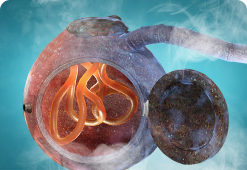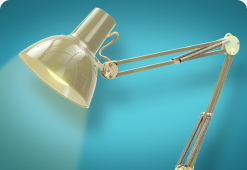A
Albumin is the main protein found in our blood.1
When a person’s urine contains a higher-than-normal amount of albumin (a protein typically found in the blood).1
A protein made by the immune system to protect the body from foreign substances such as bacteria or viruses.1
B
A procedure in which a needle is used to extract small pieces of tissue for examination with different types of microscopes, each of which shows a different aspect of the tissue.2
Loss of mental sharpness and fuzzy thinking.3
C
When a disease lasts for at least 3 months (but is usually lifelong) and tends to get worse over time.4,5
A series of x-ray images taken from different angles and processed using computer software. CT scans give a more detailed picture of inside the body than single x-rays do.6
A waste product that’s naturally produced by our muscles and can be used by doctors to estimate how well the kidneys are working.7
D
When a machine outside of your body filters your blood for you to remove waste products and excess fluid.8
E
An estimate of how well your kidneys remove waste products from your blood.9
F
Extreme tiredness with very little motivation or energy.10
The sides of the abdomen and back, between the lower ribs and hips, where the kidneys are located.11,12
G
A way to detect changes in genes that can cause health problems.13
A type of kidney disease caused by damage to the glomeruli (the tiny filters within the kidney that clean our blood).2
Tiny filters within the kidney that clean our blood.2
H
When there is blood in your urine. If the blood is visible to the naked eye, it is called macrohaematuria. If not, it is called microhaematuria.14
When the pressure in your blood vessels is too high.15
I
A type of glomerular disease that occurs when an abnormal form of an antibody called immunoglobulin A (IgA) builds up in the kidneys, causing inflammation that damages kidney tissues.1
A type of antibody.1
When viruses, bacteria, or other microbes enter your body and begin to multiply.16
The body’s immune system’s response to an irritant, such as bacteria or a foreign object (like a splinter).17
K
Two bean-shaped organs, each about the size of a fist, located just below the rib cage (the flank), one on each side of your spine.11,12
When your kidneys are damaged and can’t filter blood the way they are supposed to.18
N
When the level of protein in a patient’s blood is extremely high, which is generally considered to be above 3 g per day.2,19
A group of symptoms associated with kidney damage such as large amounts of protein in your urine (nephrotic range proteinuria), low levels of protein in your blood and oedema.20
O
Swelling caused by too much fluid trapped in the body's tissues, usually in the legs and feet.21
P
When protein leaks into the urine, causing foamy urine.22 It is also called albuminuria.22
R
A disease that affects very few patients.23,24
A non-invasive procedure that uses ultrasound or computed tomography (CT) to scan the kidneys and check that they are a normal shape and size.2
T
When something is poisonous or harmful to the body, often causing unwanted side effects.25
When tissue or an organ is transferred from one area of a person’s body to another, or from one person to another.26
U
A procedure that uses sound waves to look at tissues and organs inside the body.27
Urea nitrogen is a waste product that is naturally produced after the liver breaks down proteins.7 When the kidneys aren’t working well, the level of urea nitrogen in the blood goes up, indicating that the kidneys aren’t removing it as efficiently as they should.7 Doctors use it to estimate how well the kidneys are working.7
A urine test used to detect and manage a wide range of disorders, including kidney disease.28

About glomerular disease
Learn about glomerular disease.

Asking your doctor
Download a discussion guide to help you speak to your healthcare team.

Diagnosis
Find out how glomerular diseases are diagnosed.

Symptoms
Understand the signs and symptoms of glomerular disease.